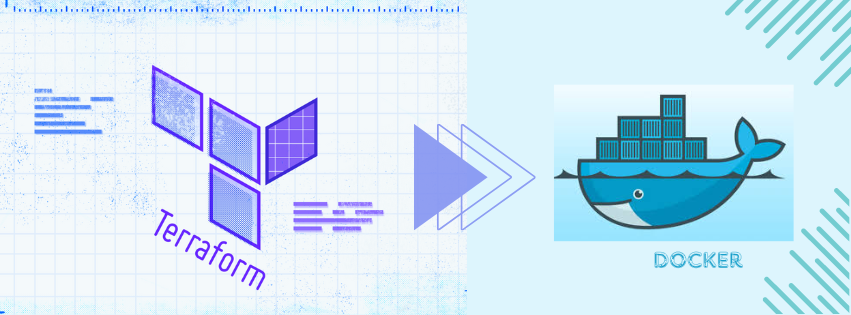Seamless Docker Container Deployment Using Terraform
Deploying Docker containers can be a complex process, especially when managing infrastructure at scale. Terraform, an open-source infrastructure as code (IaC) tool, simplifies this process by providing a consistent workflow for provisioning and managing infrastructure across various cloud providers. In this blog, we'll explore how to deploy Docker containers using Terraform, a powerful combination that brings automation, consistency, and scalability to your infrastructure management.

Use Case
Imagine you are responsible for deploying a microservices-based application that consists of multiple Docker containers. Each service has its own dependencies, scaling requirements, and network configurations. Managing these services manually can quickly become unmanageable. By leveraging Terraform, you can automate the deployment process, ensure consistency across environments, and easily scale services as needed.
- Microservices Deployment: Automate the deployment of a microservices-based application consisting of multiple Docker containers.
- Dependency Management: Handle each service's dependencies, ensuring that all necessary components are properly configured and available.
- Scaling Requirements: Easily scale services up or down based on demand without manual intervention.
- Network Configurations: Define and manage network configurations for seamless communication between services.
- Environment Consistency: Ensure consistency across development, staging, and production environments by using infrastructure as code.
- Simplified Management: Reduce the complexity of managing multiple services manually by leveraging Terraform for automated deployments.
- Infrastructure Reproducibility: Define infrastructure as code to easily reproduce environments for testing, staging, and production.
- Streamlined Deployment Process: Simplify and standardize the deployment process, allowing developers to focus on building and improving applications.
Requirements
Before we dive into the setup, ensure you have the following prerequisites:
- Terraform: Install Terraform on your local machine.
- Docker: Install Docker on your local machine.
- Docker Hub Account: Create a Docker Hub account to store your Docker images.
- Docker Images: Build and push your Docker images to Docker Hub.
Steps to Set Up Docker Deployment Using Terraform
1. Install Terraform and Docker
Ensure both Terraform and Docker are installed on your machine. Verify the installations by running the following commands:
terraform -v
docker -v
2. Create a Docker Compose File
Create a docker-compose.yml file that defines your services. This file will be used to describe your application's services, networks, and volumes.
version: '3'
services:
web:
image: girishcodealchemy/alchemy-nginx:v5
ports:
- "80:80"
db:
image: postgres:latest
environment:
POSTGRES_USER: postgres
POSTGRES_PASSWORD: password
POSTGRES_DB: mydb
volumes:
- db-data:/var/lib/postgresql/data
volumes:
db-data:
3. Write Terraform Configuration
Create a directory for your Terraform files and navigate into it:
mkdir terraform-docker
cd terraform-docker
Create a main.tf file and add the following configuration to define your Docker provider and resources:
terraform {
required_providers {
docker = {
source = "kreuzwerker/docker"
version = "~> 3.0.2"
}
}
required_version = "~> 1.5"
}
provider "docker" {
host = "unix:///var/run/docker.sock"
}
resource "docker_network" "my_network" {
name = "my_network"
}
resource "docker_volume" "db_data" {
name = "db_data"
}
resource "docker_container" "web" {
name = "web"
image = "girishcodealchemy/alchemy-nginx:v5"
ports {
internal = 80
external = 80
}
networks_advanced {
name = docker_network.my_network.name
}
}
resource "docker_container" "db" {
name = "db"
image = "postgres:latest"
env = [
"POSTGRES_USER=postgres",
"POSTGRES_PASSWORD=password",
"POSTGRES_DB=mydb"
]
volumes {
volume_name = docker_volume.db_data.name
container_path = "/var/lib/postgresql/data"
}
networks_advanced {
name = docker_network.my_network.name
}
}
4. Initialize Terraform
Run the following command to initialize the Terraform configuration. This command downloads the Docker provider and prepares your workspace.
terraform init
5. Perform the Terraform plan
Run the following command to create an execution plan:
terraform plan
Terraform will display a plan of the changes it will make. Review the plan carefully.

6. Apply the Terraform Configuration
Run the following command to apply the configuration and deploy your Docker containers:
terraform apply
Terraform will display a plan of the changes it will make. Review the plan and type yes to proceed with the deployment.

7. Verify the Deployment
After the deployment is complete, verify that the containers are running by using the Docker CLI:
docker ps
You should see your web, and db containers running.

8. Destroy the Docker containers
To clean up the infrastructure, run the destroy command:
terraform destroy

Exploring the Full Code on GitHub
To view the complete code for deploying Docker containers using Terraform, visit the GitHub repository. This repository contains all the necessary files and detailed instructions to help you get started with automating your Docker deployments using Terraform.
Conclusion
Using Terraform to deploy Docker containers brings automation and consistency to your infrastructure management. This approach allows you to define your infrastructure as code, making it easy to reproduce and scale your deployments across different environments. By following the steps outlined in this blog, you can streamline your deployment process and focus on building and improving your application.
🚀 Stay tuned for more empowering insights into the world of Docker and Terraform automation. Happy deploying!! 🌐
. . . . .
✈️ Github: github.com/GirishCodeAlchemy✈️
✈️ Linkedin: linkedin.com/in/vgirish10